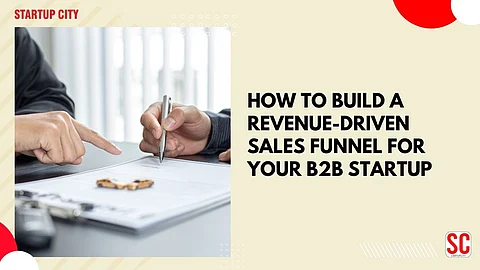

“The aim of marketing is to know and understand the customer so well the product or service fits him and sells itself.”
Peter Drucker
Let me ask you a hard-hitting question:
Do you really have a sales funnel, or are you just winging it?
If you're a B2B startup founder, CEO, or decision-maker, you already know that generating leads isn’t the end goal. Revenue is. Yet, many startups are stuck in a loop of marketing activities without a revenue-driven strategy behind them.
In my experience working with fast-growing B2B startups, the difference between those that scale and those that stall is a well-built, laser-focused sales funnel—one designed not just to attract, but to convert and retain high-value clients.
So today, let me show you how to build a revenue-driven sales funnel that’s not just a buzzword, but a system that predictably fuels growth for your B2B business.
At its core, a revenue-driven sales funnel is a step-by-step system designed to guide your prospects through their journey—from discovering your brand to becoming paying, long-term customers.
Unlike a traditional funnel that just maps stages (awareness, interest, decision, action), a revenue-focused funnel goes deeper. It aligns marketing, sales, and customer success around one goal: increasing lifetime customer value (LTV).
Better quality leads instead of more cold leads
Shorter sales cycles through targeted nurturing
Higher conversion rates due to personalized experiences
Scalable growth driven by data-backed decisions
Before building anything, you must know who you’re building it for.
Ask yourself:
Who benefits the most from your product or service?
What are their pain points, KPIs, and goals?
What triggers their buying decisions?
Pro Tip: Use real data. Interview your best customers. Study their journey. Tools like HubSpot, Apollo, or even LinkedIn Sales Navigator can help segment prospects by company size, revenue, industry, and job title.
"If you’re speaking to everyone, you're speaking to no one."
Let’s break the funnel down into five clear, revenue-focused stages:
Funnel Stage
Goal
Example Tactic
Awareness
Educate & attract
SEO blogs, LinkedIn content, webinars
Interest
Build trust & relevance
Lead magnets, case studies, newsletters
Consideration
Showcase value & differentiation
Product demos, sales calls, ROI calculators
Decision
Close with confidence
Personalized offers, proposal walkthroughs
Post-Sale
Retain, upsell, and evangelize
Onboarding, check-ins, customer marketing
Make sure you assign KPIs to each stage: traffic, CTR, SQLs, MQLs, CAC, etc.
If you're still using generic "Download Our Brochure" CTAs—stop now.
You need high-value, problem-solving content that attracts decision-makers, not window shoppers.
A free B2B benchmark report
ROI calculator tailored to your niche
Industry-specific playbooks
Access to a private Slack or LinkedIn community
Exclusive founder-led webinars
Your goal? Move the prospect to the next stage, not overload them with fluff.
This is where many B2B startups go silent. But let me be clear—not every lead is ready to buy now.
Enter email nurture sequences, retargeting campaigns, and drip content—designed to educate and move the needle.
Day 1: Welcome email + valuable content
Day 3: Case study relevant to their industry
Day 6: Invite to webinar or podcast episode
Day 9: Soft sales CTA (e.g., “Interested in seeing how we did this for X client?”)
Use tools like Mailchimp, ActiveCampaign, or HubSpot to automate this.
"People don’t buy when you want them to. They buy when they trust you enough."
In a revenue-driven funnel, marketing doesn’t just pass the baton to sales—it runs the race with them.
That means:
Shared KPIs (like SQLs and revenue attribution)
Feedback loops between sales calls and marketing content
Real-time CRM data integration
In my experience, startups that bring sales and marketing into one growth team see up to 36% higher customer retention (source: Aberdeen Group).
Want to convert faster? Start tracking what your prospects do, not just what they say.
Use tools like Clearbit, Leadfeeder, or Hotjar to:
Track which pages a lead visits
Score leads based on behavior
Trigger sales alerts when a lead shows buying intent (like viewing the pricing page)
Behavioral triggers = gold mines for timely, contextual outreach.
Remember: This isn’t a “set it and forget it” system.
You need to track, test, and tweak consistently. Focus on metrics that matter:
CAC (Customer Acquisition Cost)
LTV (Lifetime Value)
Conversion Rate at Each Funnel Stage
Sales Velocity (average time to close)
Use this data to make micro-pivots in messaging, targeting, or offer positioning.
A B2B SaaS client I worked with (India-based, targeting global HR teams) saw 0 to $500K ARR in 14 months. The secret? They:
Defined a narrow ICP (HR heads in tech startups)
Created an “HR Tech ROI Calculator” as their lead magnet
Used a nurture email series tied to hiring seasons
Offered free audits before upselling their SaaS
Built a referral engine post-sale
They didn’t chase leads. They built a predictable pipeline of high-intent buyers.
Let’s be honest—you’re not building a funnel for vanity metrics.
You’re building a system that feeds your business with revenue, month after month.
And now you know how.
What stage is currently broken in my funnel?
Am I tracking revenue, or just traffic?
What can I start doing this week to optimize conversions?
Building a revenue-driven sales funnel isn’t optional—it’s essential.
Whether you're a SaaS startup in Bengaluru, a fintech venture in Mumbai, or a B2B service provider eyeing the global market, this is your growth engine.
Start small. Stay focused. Optimize relentlessly.
You don’t need 10,000 leads. You need the right 100, nurtured and converted with care.
If you’re ready to make your funnel work for your revenue goals, don’t wait. Start building it now.